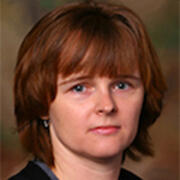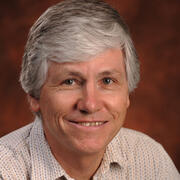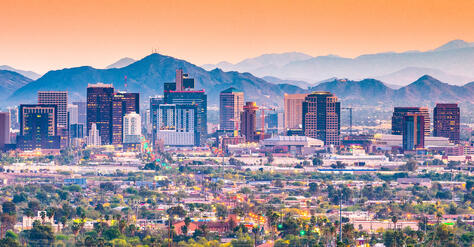Have questions about this report? Ask the author(s).
In Maricopa County, 28 employment centers were identified based on 2021 employment data. An employment center is a contiguous area with total employment at least 8,875, employment density (employment per square mile) of at least 4,650, and employment per 1,000 residents of more than 410. An employment center with an employment density of less than 5,675 is considered to be marginal.
Ten of the employment centers form a contiguous area, stretching west from northwest Tempe to west of downtown Phoenix, then north along Central Avenue and east along Camelback Road. The employment density exceeded 5,675 in each of these centers except the area encompassing Sky Harbor Airport, which has much of its land area dedicated to the airport’s runways.
South and east of northwest Tempe, six more centers are nearly contiguous, extending east into downtown Mesa, and southeast into Chandler. Only one of these employment centers had an employment density of less than 5,675. In addition to this large, nearly contiguous area, 12 outlying employment centers are located in Phoenix, Scottsdale, Mesa, and Chandler. Four of these 12 outlying centers had an employment density of less than 5,675.
Employment centers in Metro Phoenix are disproportionately located southeast of downtown Phoenix, extending to east of the alignment of 88th Street. The most westerly edge of one employment center is 59th Avenue, but otherwise no center extends west of 35th Avenue.
The 28 employment centers range in size from about three-fourths of a square mile to around 5 square miles, with an average of 2.94 square miles. Combined, the 28 centers cover just 0.9 percent of Maricopa County’s land area, but accounted for 37 percent of the county’s employment in 2021. Average employment per center was approximately 24,500 and the average density was 8,326 workers per square mile. Each center had employment per 1,000 residents far in excess of the 410 criterion.
Employment growth between 2007 and 2021 in the 28 employment centers combined was 22 percent, a little less than the county’s 27 percent. Each of the six centers with an employment density of more than 10,000 in 2021 are long established, located in the core area of Metro Phoenix, and experienced average or below-average employment growth: downtown Phoenix, the area along the Papago Freeway in central Phoenix, midtown Phoenix, the area around the state capital, downtown Tempe, and downtown Scottsdale.
In contrast, of the eight employment centers with employment growth of more than 50 percent between 2007 and 2021, seven are located well away from the Metro Phoenix core: two in Chandler, one in Mesa, one in north Scottsdale, two along the I-17 Freeway in north Phoenix, and one along the I-10 Freeway in west Phoenix. The exception is downtown Tempe, the only employment center with a density of more than 10,000 in 2021 and employment growth between 2007 and 2021 of more than 50 percent. In general, employment growth rates are highest well away from the metro core but within the fringe of the urbanized area, but most of these fast-growth areas in 2021 did not have enough employment or employment density to meet the criteria of an employment center.

Eva received her B.S. in finance from Babes-Bolyai University in Romania, a M.S. in business management from Politehnica University in Romania, and a M.A. in economics from Western Michigan University in 2000. She worked as a research analyst at the W. E. Upjohn Institute in Kalamazoo, Michigan prior to joining ASU’s L. William Seidman Research Institute in 2007.

After receiving his Bachelor of Business Administration from the University of Toledo, Tom earned his Master of Business Administration from Arizona State University in 1976. After working in the private sector, he joined ASU in 1980, working for the predecessor of the L. William Seidman Research Institute. Since 2005, he has served as manager of research initiatives in the Office of the University Economist.

An update to the November 2023 paper that presented data through 2022, estimates are presented of the number of ASU graduates working in Arizona, as well as their average wage, aggregate wages, and tax payments. Estimates are made for each year from 2012 through 2023.

Summarizes migration data by state from three sources: the Internal Revenue Service, the American Community Survey, and the University of Wisconsin.
EXECUTIVE SUMMARY

Examines the determinants of the locations of high-tech clusters in the United States. Summarizes the development of high-tech activities in Arizona, Metro Phoenix, and Metro Tucson relative to selected states and metropolitan areas.
…